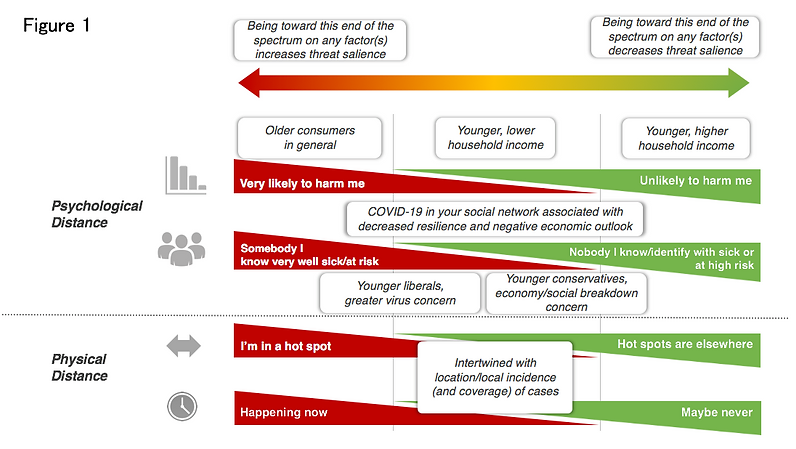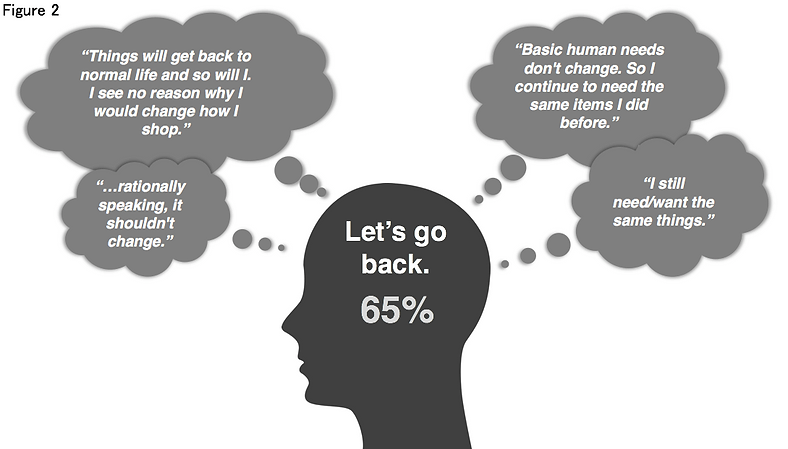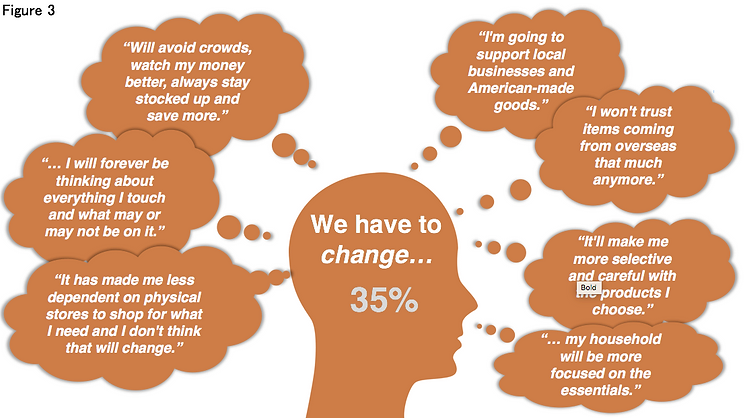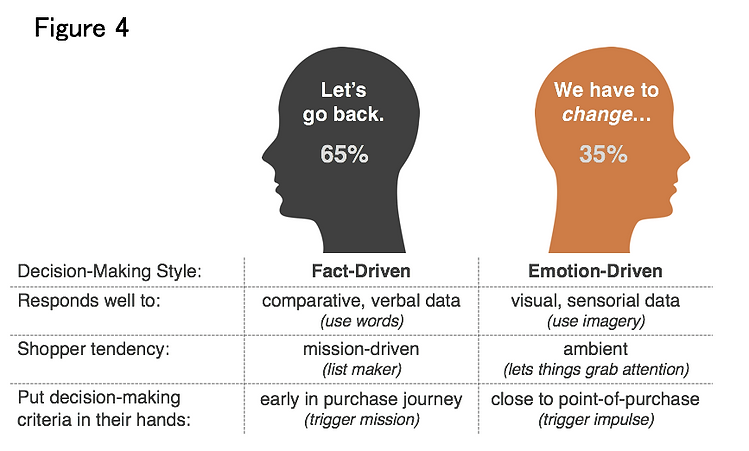Durable neuropsychological factors can help predict — and influence — consumer behavior post-pandemic.
This article was originally published in Quirks
Authors: T. Sigi Hale, Mary Mathes, and Hunter Thurman
We’ve heard the word “unprecedented” a lot over these past months, with good reason, as we all try to adjust to and make sense of life amid a global pandemic. It’s true there are many unknowns, but while the context of our daily lives has changed dramatically, the fundamental nature of human psychology remains stable, and within it lies the keys to understanding and predicting what is likely to happen next.
Our research suggests that when it comes to predicting post-pandemic consumer behavior, there really are two kinds of people in the world: those who will want to return to the way things were, and those who will be driven to change. And it may surprise you that the “let’s go back” camp is the larger cohort: 65% of respondents to our recent study fall into this group; 35% feel more positively about change and expect it to happen.
Companies trying to anticipate what their target consumers will do next should aim to answer two key questions: 1) How salient is the threat for them? and 2) How will they seek to regain control? That is, which type of person is their consumer: one who will seek a return to the way things were, or one who will strike out into the brave new world, open to the changes it brings?
Framing our approach
We began our effort to design a study that would help us contextualize consumer behavior in the wake of COVID-19 with a comprehensive white paper review so we could stand on the shoulders of existing knowledge. Our team dug into the academic literature and psychological models – both our own and those of the academic community – to unearth what is already known about how humans react to uncertain situations such as crises, pandemics and recessions.
This sweeping review of more than 120 articles informed our design of a primary research instrument that would help us gain a deeper understanding of what’s going on in consumers’ minds amid this situation and what it means for how they are likely to move forward. We partnered with EMI Research Solutions to survey 998 U.S. respondents online from April 17-22, 2020. EMI handled programming, hosting, sample and fieldwork.
We captured a detailed demographic and psychographic battery including employment and income impacts from the pandemic, political leaning, resilience measures, openness to change and perceived impacts of the pandemic on six key aspects of life: people/social, work/vocation, learning/education, entertainment/leisure, food/drink and culture/cultural norms. Lastly, we asked our proprietary, implicit neuropsych measures of core motives and costs that reveal at a pre-conscious level how respondents make decisions.
Taking all of this together we’ve determined that two questions can serve as a helpful guide for making sense of this mess.
Question 1: How salient is the threat? (AKA, when will this be over?)
The academic literature provides a framework for thinking about this question. Construal Level Theory describes the relationship between the physical and psychological distance of objects, events and people and how they are construed or mentally represented, from the very close and concrete to the distant and abstract. This in turn impacts how people will perceive, predict and behave.1
We find this to be a useful way to gauge how different people perceive the threat from the pandemic. How “close” is the threat both psychologically (How likely do I think I am to get sick, and is anyone in my own social network sick or at high risk?) and physically (How close am I to a “hot spot,” and how imminent is the threat of exposure/contagion?)
Layering the findings of our April study onto this framework, we began to contextualize the elements of the threat with this diagram:

Determining how salient the threat is to a particular consumer target will begin to illuminate when they are likely to perceive that the threat is over. This is where demographic and political differences come into play, and the graphic helps you think about where your group(s) of interest likely lie on the continua.
Older consumers tend to recognize the likelihood of the pandemic harming them is higher. Interestingly among younger respondents, household income level plays a role in determining how likely they think it is that the pandemic will harm them, with higher income households tending to perceive the threat to be more distant. Income is likely in part an imperfect proxy for occupational field here, with many higher paying jobs more likely to offer the ability to work from home and/or more job security, though of course this is not a perfect correlation, as many health care workers would attest.
The other aspect of psychological distance, whether the threat exists in one’s social network, is directly related to one’s assessment of the risk. For example, people who know a sick or high-risk person tend to report lower resilience and increased fear about the future. This is also associated with greater concern about the virus, while those who do not perceive the threat within their social networks worry more about the effects on the economy and social order.
Physical distance is directly related to proximity to outbreaks. As just one example, we’re reminded of an article several weeks back reporting that some residents in upstate New York opposed being subject to the same stringent lockdown rules as New York City: in their minds, the virus was “down there,” and thus they did not feel the threat as acutely, or think it warranted the same reaction.
Academic studies of past pandemics suggest that once the acute threat subsides, there will be a four-to-six month period in which residual anxiety, fear and frustration will linger and behaviors will be malleable.2 It is during this period in particular when consumers’ answer to the second question will be key to determining how to engage them.
Question 2: How do I regain a sense of control?
As noted earlier, our survey revealed two primary mind-sets that people will use to regain a feeling of control over their situation.
Let’s go back
This mind-set describes 65% of U.S. respondents. Psychologically, this group is more fact driven, and change resistant. They value the “tried and true” and tend to stick with what works.
Nearly all aspects of their lives have changed because of the pandemic, and not for the better. These people are circling the wagons and following the rules to get through the threat of the virus, which worries them. But what they were doing before worked just fine and once the threat feels sufficiently vanquished, they want and expect to go back to it. They’re not interested in a new normal.
This group is optimistic that things will go back to normal, including their financial situation, and because of this they feel less afraid of what the future will bring. They do expect some of the more social aspects of life will remain changed, likely understanding that guidelines and precautions around things such as large gatherings will be in place for the foreseeable future.
Further, the back to normal camp isn’t drastically changing what they buy because of the pandemic; they still want and need the same things and expect to want and need those things when this is over. While many agree that their shopping style has changed, they are less likely to expect it to remain different long-term, and do not expect the types of products they buy to change.
We captured a few representative quotes of the key attitudes shared by this cohort:

Let’s change
The other 35% will adopt this mind-set to regain control. Psychologically, this group is more about senses and feelings than facts and is more inclined toward exploring and trying new things.
They have also experienced changes to all aspects of life under the pandemic, but for them, some of these changes are positive. This likely contributes to their greater change readiness and openness to a new normal as we go forward. They are keen to see what comes next after all this, but because it’s all new and unknown, it’s scary. This group tends to worry more about the economic and social order impacts of this situation than the virus itself.
The let’s change camp expects many of the ways they live and shop to remain different when the threat has ended. They perceive that the pandemic has changed all aspects of daily life and tend to expect all aspects of life to remain changed.
When it comes to their shopping habits, they talk about more than just increased online buying: we also see themes of wanting to keep more staples on hand “just in case;” buying more U.S.-made goods and supporting local / small businesses; focusing more on essentials; and being more cognizant of germs/careful with the products they choose.
Again, here are a few quotes that sum up the key themes of this group:

One more important finding about these two camps: demographically, they are remarkably similar. The “let’s change” camp trends slightly younger than the “let’s go back” cohort, but the difference is not statistically significant, falling just outside the standard 95% confidence interval. Across all other metrics we captured – gender, ethnicity, income, household size, urban vs. rural and region – there are statistically no differences. These are truly two cohorts of mind-set, not socioeconomics or life circumstance.
Again, the spectra of the Construal Level Theory model are really where we see changes in threat perceptions by demographics, but once people feel that the threat has passed, their reaction will be all about their psychology.
How to reach each mind-set
Brands that figure out what psychological camp their target consumers are in and how to speak the language of that camp will be poised to succeed. This may mean more tailored strategies across geographies as the pandemic continues to run its course in the U.S.
This table provides a handy cheat sheet for how to approach messaging each mind-set:

This pandemic is changing virtually all aspects of life, but fundamental human psychology doesn’t change so quickly. We all want to regain a sense of control. Companies that recognize and facilitate their target consumers’ preferred way of feeling in control, whether getting back to normal or forging ahead into the next normal, will be best positioned to regain their own sense of control and find success in a post-pandemic consumer world.
References
Labroo, A. A., and Patrick, V. M. (2008). “Psychological Distancing: Why Happiness Helps You See the Big Picture.” Journal of Consumer Research, 35.
Liberman, N., Trope, Y., and H Auden, by W. (2008). “The Psychology of Transcending the Here and Now.” Musée des Beaux Arts, SCIENCE (Vol. 322).
Trope, Y., and Liberman, N. (2003). « Temporal construal.” Psychological Review, 110(3), 403–421.
1 Trope, Y., and Liberman, N. (2010). “Construal-Level Theory of Psychological Distance.” Psychological Review, 117(2), 440–463.
Blendon, R. J., Benson, J. M., DesRoches, C. M., Raleigh, E., and Taylor‐Clark, K. (2004). “The Public’s Response to Severe Acute Respiratory Syndrome in Toronto and the United States.” Clinical Infectious Diseases, 38(7), 925–931.
Jeong, H., Yim, H. W., Song, Y. J., Ki, M., Min, J. A., Cho, J., and Chae, J. H. (2016). “Mental health status of people isolated due to Middle East Respiratory Syndrome.” Epidemiology and Health, 38, e2016048.




